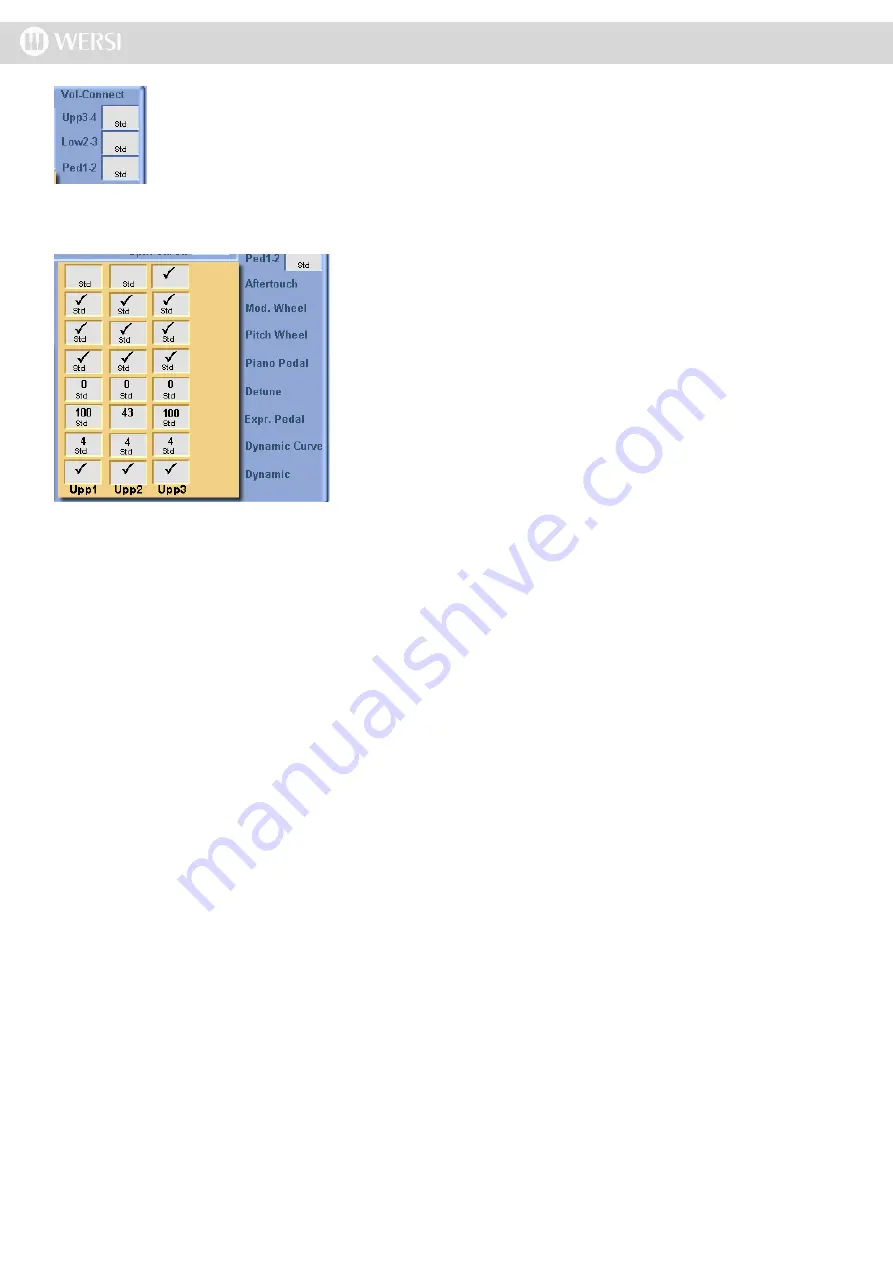
The settings shown to the left are controlled by ‘Tick’ check boxes
that are simply pressed or by pressing the box and altering the value
of the data box by using the Data / Tempo wheel.
•
Vol-Connect
- This area is for instruments with the ‘Selector Plus’ options. It allows you to con
-
nect the additional selectors to the physical ‘grey volume drawbars’.
•
Upp3-4
- Check this box to connect the grey volume drawbar for Upper 3 to control the Upper 4
volume.
•
Low2-3
- Check this box to connect the grey volume drawbar for Lower 2 to control the Lower 3
volume.
•
Ped1-2
- Check this box to connect the grey volume drawbar for Pedal 1 to control the Pedal 2
volume.
•
Aftertouch
- (Upper Manual Only). Check this box to activate the ‘Aftertouch’ effect for the Upper Manual Selec
-
tors.
•
Mod. Wheel
- (Upper Manual Only) Check this box to set which Upper Manual Selector / Sound you would like to
be affected by the Modulation Wheel.
•
Pitch Wheel
- (Upper Manual Only) Check this box to activate which Upper Manual Selector / Sound you would
like to be affected by the Pitch Wheel.
•
Piano Pedal
- Check this box if you would like any of the Selectors / Sounds to respond to the ‘Piano Pedal’ of the
GigaPiano GP1000 (Only WERSI GigaPiano). If the box is checked, the sound of the manual continues even after
the keys are released, as long as the piano pedal is pressed.
•
Detune
- This Data Value box allows you to tune +50 cents in pitch and -50 cents in pitch for all Selectors /
Sounds.
•
Expr. Pedal
- This Data Value box allows you to change / adjust the polarity of the Volume / Expression pedal.
When the value is set to ‘100’, the pedal works in the traditional way (Accelerate for more volume). When the
pedal is set to ‘-100’, the pedal works in the opposite manner to how it usually works. You ‘accelerate to decrease
the volume. The values in between ‘100’ and ‘-100’ naturally produce some very expressive effects, and allow you
to inter-weave sounds in a natural way (similar to how a real orchestra might perform an ‘expressive’ musical pas
-
sage for example).
•
Dynamic Curve
- Change between the different ‘Dynamic Curve’ settings. There are several Dynamic Curves
available from ‘Soft Dynamics’ to ‘Hard Dynamics’.
•
• 0 = No Dynamic
• 1 = Little Dynamic (Old OAS Version 4.1 Dynamics)
• 2 = Average Dynamic (From OAS Version 4.1 Dynamics)
• 3 = Normal Dynamics
• 4 = Soft Dynamics
• 5 = Hard Dynamics
• 6 = Restricted Dynamics
• 7 = Extremely Restricted Dynamics
• 8 = Like Dynamic 3, But Inverse (Fading Out Sounds At Stronger Velocity)
• 9 = Like Dynamic 4, But Inverse (Fading Out Sounds At Stronger Velocity)
• 10 = Cross-Switch, Full Sound From Value 110 (0 Till 109, No Sound). 110-127, Full Sound.
• 11 = Cross-Switch, Normal Dynamic Up To Value 110. Value 111 to 127, No Sound.
Summary of Contents for Abacus
Page 1: ...Abacus Verona Vegas User Manual Edition 18 02 2011 V 1 Gedownload bij www wersi fan nl ...
Page 88: ...User Notes ...
Page 89: ...User Notes ...
Page 90: ...User Notes ...
Page 91: ...User Notes ...
Page 92: ...User Notes ...
Page 93: ...User Notes ...
Page 94: ...User Notes ...
Page 95: ...User Notes ...
















































